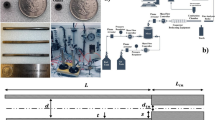Abstract
The methane combustion with hydrogen addition can effectively reduce carbon emissions in the iron and steel making industry, while the combustion mechanism is still poorly understood. The oxy-fuel combustion of methane with hydrogen addition in a 0.8 MW oxy-natural gas combustion experimental furnace was numerically studied to investigate six different combustion mechanisms. The results show that the 28-step chemical reaction mechanism is the optimal recommendation for the simulation balancing the numerical accuracy and computational expense. As the hydrogen enrichment increases in fuel, the highest flame temperature increases. Consequently, the chemical reaction accelerates with enlarging the peak of the highest flame temperature and intermediate OH radicals. When the hydrogen enrichment reaches 75 vol.%, the flame front is the farthest, and the flame high-temperature zone occupies the largest proportion corresponding to the most vigorous chemical reactions in the same oxygen supply.











Similar content being viewed by others
References
H.J. Karimi, M.H. Saidi, J. Iron Steel Res. Int. 17 (2010) No. 4, 12–17.
Y. Lipo, L. Yunpeng, H. Yingwu, Z. Yongshun, International Journal of Low-Carbon Technologies 17 (2022) 308–320.
N. Rafidi, W. Blasiak, Appl. Therm. Eng. 26 (2006) 2027–2034.
M. Gu, G. Chen, X. Liu, C. Wu, H. Chu, Int. J. Heat Mass Transfer 76 (2014) 405–410.
W. Blasiak, W.H. Yang, N. Rafidi, Combust. Flame 136 (2004) 567–569.
S.H. Han, D. Chang, C. Huh, Energy 36 (2011) 1265–1272.
G. Tang, B. Wu, D. Bai, Y. Wang, R. Bodnar, C.Q. Zhou, Int. J. Heat Mass Transfer 113 (2017) 1142–1151.
A. Laukka, E.P. Heikkinen, T. Fabritius, Metals 11 (2021) 621.
X. Jiang, P. Li, J. Guo, F. Hu, F. Wang, J. Mi, Z. Liu, Int. J. Hydrogen Energy 43 (2018) 8534–8557.
J. Min, F. Baillot, A. Wyzgolik, E. Domingues, M. Talbaut, B. Patte-Rouland, C. Galizzi, Combust. Sci. Technol. 182 (2010) 1782–1804.
F. Liu, H. Guo, G.J. Smallwood, Ö.L. Gülder, Combust. Flame 125 (2001) 778–787.
Y. Yan, W. Tang, L. Zhang, W. Pan, Z. Yang, Y. Chen, J. Lin, Int. J. Hydrogen Energy 39 (2014) 1864–1873.
J. Wang, Z. Huang, C. Tang, H. Miao, X. Wang, Int. J. Hydrogen Energy 34 (2009) 1084–1096.
Q. Jiao, H.Y. Miao, Z.H. Huang, D.M. Jiang, K. Zeng, J. Combust. Sci. Technol. 15 (2009) 259–265.
H. Wu, K.J. Mu, Y. Wang, Y.H. Xiao, Journal of Engineering for Thermal Energy and Power 25 (2010) 102–106.
M. İlbaş, İ. Yılmaz, Int. J. Energy Res. 36 (2012) 643–647.
F. Moreno, J. Arroyo, M. Muñoz, C. Monné, Int. J. Hydrogen Energy 37 (2012) 13564–13573.
M. Ayoub, C. Rottier, S. Carpentier, C. Villermaux, A.M. Boukhalfa, D. Honoré, Int. J. Hydrogen Energy 37 (2012) 6912–6921.
A. Mardani, S. Tabejamaat, Int. J. Hydrogen Energy 35 (2010) 11324–11331.
E. Hu, Z. Huang, J. Zheng, Q. Li, J. He, Int. J. Hydrogen Energy 34 (2009) 6545–6557.
A. Mardani, Fuel 191 (2017) 114–129.
W. Jin, C. Ren, J. Li, J. Wang, Y. Yan, Fuel 310 (2022) 122292.
S.H. Han, D. Chang, Int. J. Heat Mass Transfer 55 (2012) 4079–4087.
C. Yin, S. Singh, S. Sanchez Romero, Energy Procedia 120 (2017) 564–571.
J.Y. Murthy, S.R. Mathur, J. Thermophys. Heat Transfer 12 (1998) 313–321.
J.C. Chai, H.S. Lee, S.V. Patankar, J. Thermophys. Heat Transfer 8 (1994) 419–425.
T.F. Smith, Z.F. Shen, J.N. Friedman, J. Heat Transfer 104 (1982) 602–608.
C. Yin, L.C.R. Johansen, L.A. Rosendahl, S.K. Kær, Energy Fuels 24 (2010) 6275–6282.
R. Johansson, K. Andersson, B. Leckner, H. Thunman, Int. J. Heat Mass Transfer 53 (2010) 220–230.
L. Yan, G. Yue, B. He, Appl. Therm. Eng. 94 (2016) 209–220.
C.L. Yeh, Int. J. Heat Mass Transfer 55 (2012) 3601–3617.
M. Graça, A. Duarte, P.J. Coelho, M. Costa, Fuel Process. Technol. 107 (2013) 126–137.
C. Yin, L.A. Rosendahl, S.K. Kær, Fuel 90 (2011) 2519–2529.
S. Hjärtstam, F. Normann, K. Andersson, F. Johnsson, Ind. Eng. Chem. Res. 51 (2012) 10327–10337.
W.P. Jones, R.P. Lindstedt, Combust. Flame 73 (1988) 233–249.
J. Andersen, C.L. Rasmussen, T. Giselsson, P. Glarborg, Energy Fuels 23 (2009) 1379–1389.
C.K. Westbrook, F.L. Dryer, Combust. Sci. Technol. 27 (1981) 31–43.
M. Jazbec, D.F. Fletcher, B.S. Haynes, Appl. Math. Model. 24 (2000) 689–696.
F. Breussin, N. Lallemant, R. Weber, Combust. Sci. Technol. 160 (2000) 369–397.
S.R. Turns, An introduction to combustion, Vol. 287, McGraw-Hill Companies, New York, USA, 1996.
J. E, Q. Peng, X. Zhao, W. Zuo, Z. Zhang, M. Pham, Appl. Therm. Eng. 110 (2017) 665–677.
Acknowledgements
This research was funded by the China Postdoctoral Science Foundation (2021M690975), the Opening Research Projects of State Key Laboratory of Advanced Metallurgy/Multiphase Flow in Power Engineering (K22-04, SKLMF-KF-1901) and the Jiangxi Provincial Natural Science Foundation (20212BAB214023 and 20212BDH81001) for financial support of this work.
Author information
Authors and Affiliations
Corresponding authors
Ethics declarations
Conflict of interest
The authors declare no conflict of interest.
Rights and permissions
Springer Nature or its licensor (e.g. a society or other partner) holds exclusive rights to this article under a publishing agreement with the author(s) or other rightsholder(s); author self-archiving of the accepted manuscript version of this article is solely governed by the terms of such publishing agreement and applicable law.
About this article
Cite this article
E, Dy., Weng, Ly., Tang, Gw. et al. Numerical study of effects of hydrogen addition on methane combustion behaviors. J. Iron Steel Res. Int. 30, 2173–2185 (2023). https://doi.org/10.1007/s42243-023-00965-x
Received:
Revised:
Accepted:
Published:
Issue Date:
DOI: https://doi.org/10.1007/s42243-023-00965-x




